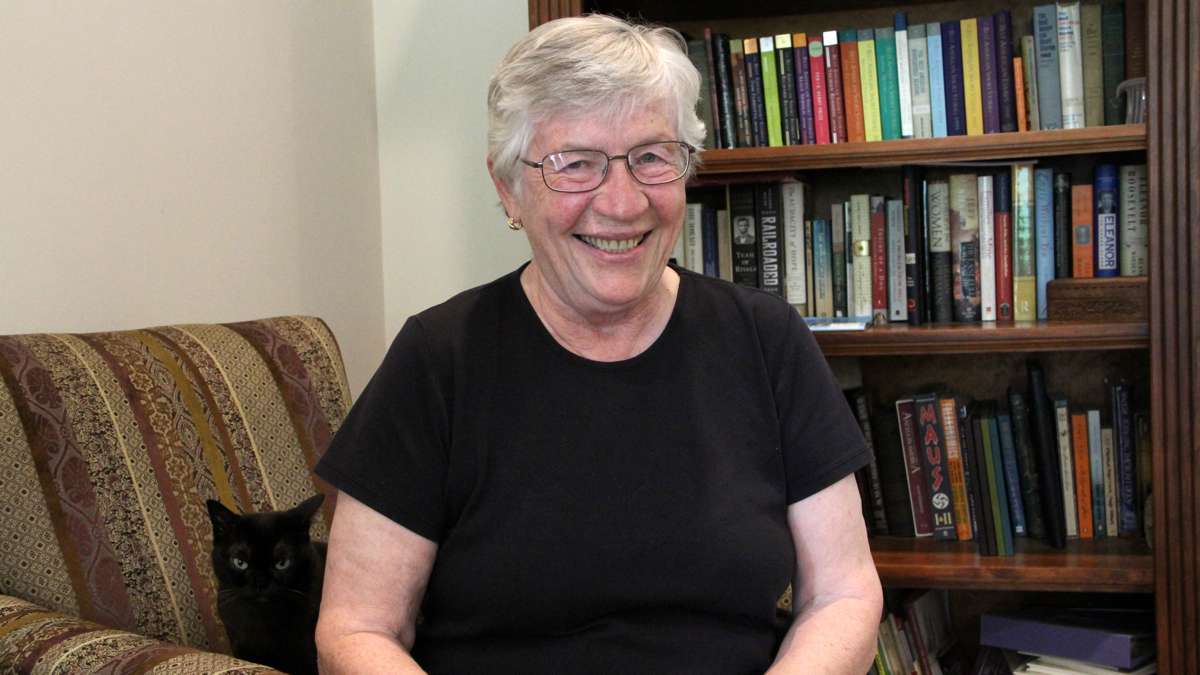Viewing Philly’s early gay rights demonstrations from the sidelines, but with no less risk
Listen
Marj McCann is a longtime gay rights activist in Philadelphia who, 50 years ago, refused to participate in the first gay right demonstrations in front of Independence Hall. The well-dressed Fourth of July picket was too risky. (Emma Lee/WHYY)
Marj McCann is a longtime gay rights activist in Philadelphia who, 50 years ago, refused to participate in the first gay right demonstrations in front of Independence Hall. The well-dressed Fourth of July picket was too risky.
Marj McCann is a longtime gay rights activist in Philadelphia who, 50 years ago, refused to participate in the first gay right demonstrations in front of Independence Hall. The well-dressed, Fourth of July picket was too risky. That doesn’t mean she wasn’t there. As a member of the Daughters of Bilitis, a lesbian activist group, she was curious to see what happened when people openly discuss homosexuality in a public place. She hovered in the perimeter of the Mall.
In the ’60s, McCann was working for Philadelphia’s city planning commission. Had she been seen taking an interest in homosexual political activity, she could have lost her job instantly as a suspected homosexual. At the time, the federal government banned gays and lesbians from holding government jobs.
McCann now lives in a retirement community in Kennett Square. She spoke to WHYY’s Peter Crimmins about what it was like 50 years ago.
—
A standard Philadelphia Fourth of July day. Summer weather, summer wear: dresses, and coats and ties. They gathered, handed out the signs, and commenced to walk in a circle. Really not much more complicated than that.
Protesters hoping the press would come, and me praying that they didn’t. There was definitely something between me and the protesters, a tree or a pole, I don’t remember. I was in a relationship with someone at the time, and she didn’t come to watch.
Obviously, people stopped to watch, but not staying too long because you didn’t want to be too close. If you were interested, you might be gay. If people expressed any support at that time, other people would assume they had a secret.
I was active in the gay rights movement at that time — through letters, speeches — but nothing in Philadelphia. No openness. This was a public event, this was something that — although the press did not cover the first year, they could have. I was not willing to put my job and my family at risk.
In the 1960s, we were continually being told we were mentally ill. Some of us believed it; some of us didn’t. If we came out at that time, we could lose our jobs, lose our families, lose our apartments. We could be instantly homeless. It was not a good plan. Those few who were able to do it, or foolhardy to do it, we kind of admired and feared them at the same time.
There were strong divisions between those who were trying to assimilate — be invisible but free — and those who wanted to change the way society looked at us. There was a lot of discussion in letters and underground newspapers about whether we should be wearing skirts, frankly.
These demonstrations combined those two elements: They were out there acting for rights, but they were wearing skirts and ties and everyone was being extremely acceptable. Conformist, if you will. Here were are, just like everybody else. Why won’t you let me have a job?
I had people say to me in the bars, “Don’t do that. They think everyone who’s gay looks like a diesel dyke. If you let them learn that we look just like anybody else, I’m in danger. Somebody might pick me out, where they would never have thought I was gay before.”
Those of us who were working on various issues were forming organizations and discussing among ourselves, but we were not public. We were meeting and thought of ourselves as a movement, but we were not yet public. These people were being public.
WHYY is your source for fact-based, in-depth journalism and information. As a nonprofit organization, we rely on financial support from readers like you. Please give today.

